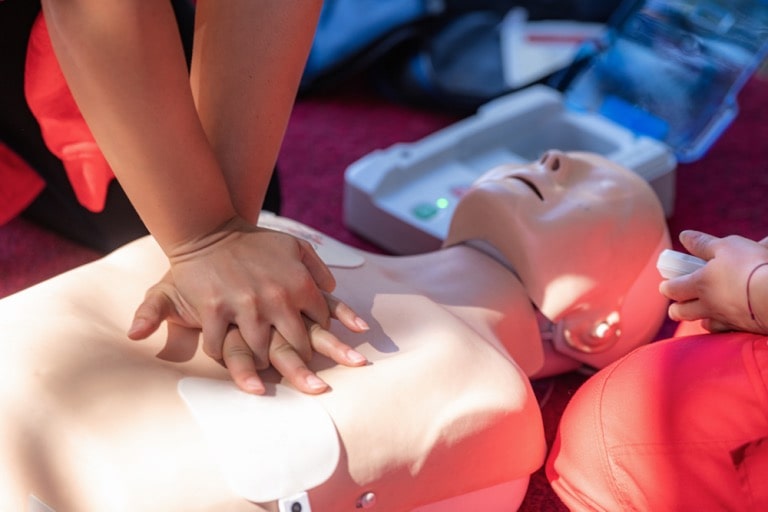3 CPR Certification Requirements for Healthcare Providers

Cardiopulmonary resuscitation (CPR) is a life-saving skill that combines chest compressions and artificial breaths to maintain blood circulation and oxygenation when the heart stops beating. In healthcare, CPR is a fundamental skill that is crucial in emergencies, such as sudden cardiac arrest.
Thus, maintaining up-to-date training in CPR for healthcare providers is essential for responsibly handling emergencies. There are different levels of CPR training available. Each is dependent on the situation of a patient. This article explains three critical types of CPR training for healthcare providers to help you understand which suits your role.
Basic Life Support
The first level of CPR training for healthcare providers is the BLS training. BLS focuses on the basic skills to respond to cardiac or respiratory arrest. You should consider getting BLS certified if you are:
- A registered nurse (RN) or licensed practical nurse (LPN)
- A Physician
- An Emergency medical technician (EMT)
- A Medical assistant
- A Respiratory therapist
- A hospital and clinic staff member
-
Core Competencies in BLS
When you pursue BLS certification, you will develop several critical skills essential for emergency response. You will be equipped to perform emergency care techniques like:
-
Airway Management
You will learn how to ensure that a patient’s airway remains open. An open airway allows proper breathing and oxygenation.
-
Chest Compressions
Effective chest compressions are vital for maintaining circulation during cardiac arrest. You will practice the correct depth and rate to maximize patients ‘ chances of survival.
-
Use of Automated External Defibrillator
AED is a medical device that can help restart the heart during sudden cardiac arrest. BLS training covers when and how to use an AED.
Advanced Cardiac Life Support (ACLS)
An ACLS course takes your emergency response training to a more advanced level. A certification course in ACLS is built upon BLS and focuses on managing cardiac-related emergencies. This training is suitable for any of these roles:
- Healthcare provider in a critical care unit or cardiac department
- Paramedic, EMT, or other prehospital care provider
- Anaesthesiologist, emergency physician, or respiratory therapist
-
Advanced Skills in ACLS CPR
ACLS training goes beyond the basics of CPR. This training teaches you the advanced skills necessary to treat a range of cardiovascular emergencies. These include:
- Cardiac arrest
- Arrhythmias
- Acute Coronary Syndrome (ACS)
- Stroke
- Severe bradycardia and tachycardia
- Shock
A comprehensive ACLS course covers the following topics:
-
Advanced Airway Management
Building on BLS skills, ACLS teaches more complex airway management techniques, including intubation and the use of advanced airway devices, such as endotracheal tubes and bag-mask ventilation.
-
Drug Therapy
You will learn to administer medications used during cardiac emergencies, such as epinephrine and atropine. The training involves complete instructions, indications, dosages, and administration routes for these drugs.
-
Post-cardiac Arrest Care
ACLS courses also teach you the strategies for stabilizing patients after a cardiac event. These strategies involve therapeutic hypothermia, monitoring, and preventing complications.
-
Handling Bradycardia and Tachycardia
Patients with dangerously slow or fast heart rates require special intervention techniques. Through the ACLS training, you will learn the use of medications and pacing necessary for these conditions.
Pediatric Advanced Life Support (PALS)
PALS specializes in caring for ill or injured infants and children. It combines BLS concepts with pediatric-specific interventions for young patients. PALS certification is essential if you work directly with children and are responsible for their care.
-
Unique Aspects of PALS Care
PALS training is distinct from BLS and ACLS due to physiological and developmental differences in pediatric patients. Here are a few unique features of PALS training and its purpose:
-
Child and Infant Care
PALS focuses on the specialized techniques for managing cardiac and respiratory emergencies in infants and children. Training in PALS emphasizes pediatric patients, who have different needs from adults.
-
Pediatric Assessment
You will learn how to assess and stabilize pediatric patients. These steps involve recognizing signs of respiratory distress, shock, and other conditions unique to children.
-
Family-Centered Care
PALS training also emphasizes the importance of involving and supporting the family during pediatric emergencies. As a healthcare provider, it is essential for you to recognize the emotional and psychological impact on both the child and their caregivers. The certification helps you develop empathy towards family members during health emergencies.
Tips on CPR for Healthcare Providers Certification
Certifications in CPR for healthcare providers are the key to providing consistent and effective emergency healthcare. Here are some tips to help you learn and retain your CPR skills:
-
Practice Regularly
Consistent practice helps you sharpen your CPR techniques. Engage in frequent training sessions to polish your skills to improve your readiness to perform CPR during real-life situations.
-
Choose a Reputable CPR for Healthcare Providers Course
Opt for a training provider endorsed by recognized bodies in the medical industry. This aspect is important to ensure you receive high-quality training that is valued nationwide.
-
Understand CPR Guidelines
CPR guidelines are periodically updated based on the latest research. Stay informed so you can apply the most current practices when administering life support.
-
Consider Online Training
Many organizations offer online CPR training options. Online training is a convenient alternative for learning life-saving measures, primarily when you work long shifts and need to get certified quickly.
Conclusion
CPR is a life-saving measure that can help to preserve the life of patients experiencing cardiac or respiratory arrest. There are various levels of CPR training, each with its specific role. However, the fundamental concept is the same: you will learn how to maintain a person’s heart and lung functioning until more advanced medical assistance arrives. Whether a nurse, EMT, or working in another healthcare position, CPR for healthcare providers will make you a valuable member of the healthcare industry.





